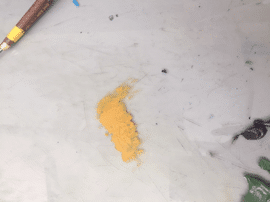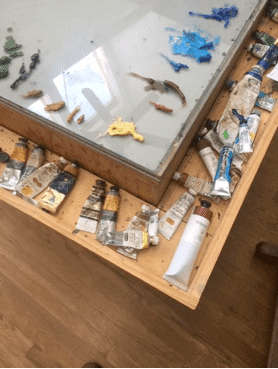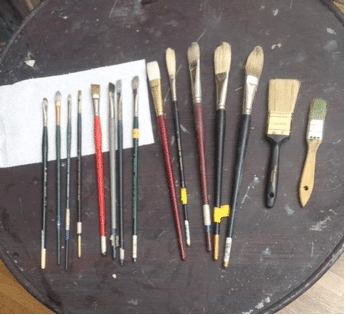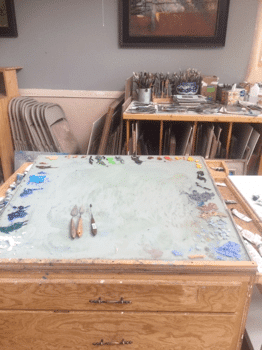On Painting Gray Tones and More > Learn how to find out if two colors are the same value with this advice from a master pastelist and oil painter.
This is part of a series of articles featuring a leader in the plein air community who will be joining us on the faculty of Pastel Live, a virtual art conference taking place September 18-20, 2024. In addition to painting with pastels, Albert Handell works with oil, as you’ll see in the following demo.
How to Paint Landscapes: Painting Gray Tones and More
By Albert Handell
alberthandellstudio.com
I paint with my large glass palette, which is 36 × 36 inches and is on top of a light gray tone with plenty of room for mixing and more.

To show you the comparative value of this gray tone, please view the image above. The gray of the palette is very close in value to the value of the yellow ocher color.
If both were photographed in black and white, the gray of the palette and the gray value of the yellow ocher color will be very close to the same gray (value). Possibly because of the intensity of the color as compared to the gray, do you think it might be lighter than the gray or simply just not the same value?
This could be confusing. To find out if they are of the same value, compare edges. If the edges are subtle or non-existent, then the values are close to each other, if not the same.
Take a step back and compare, or simply squint or take off your glasses, and you’ll see that the edges of the yellow ocher color, especially on the viewer’s upper left, drifts into the gray tone of the palette. Do you agree?
How did I get that beautiful gray tone?
That gray tone under the glass is painted with gesso paint combining raw umber and titanium white. Using raw umber with white (titanium, or any white) gives one a line of beautiful warm grays from light to dark.

Alongside my glass palette, I have a 5-inch ledge with 2 inches in height that holds my colors near where they are on the palette. This greatly helps with the organizing of my colors.

I use a large assortment of brushes and knives, depending on the size of the painting I am working on. For me 30 × 40 is the Mason-Dixon line for sizes, between large and small. A 30 × 40-inch canvas is the largest size of my small paintings, and then again it is also the smallest size of my large paintings.
If you find you are painting with a special brush or brushes in order to help keep your colors clean, please think of buying three of those brushes. One will be for the light areas, one will be for the very dark areas, and the other will be for the middle-tone areas. This should help.
Listen to Eric Rhoads interview Albert Handell in this PleinAir Podcast:
Preview Handell’s five-star art video, “Painting in Oil,” below. Included in the video is a start-to-finish painting demonstration where Albert explains each step that he takes and why. This will solidify your newfound knowledge so you can apply the techniques in your own paintings.




